- Mastering Wing Chun Kung Fu: The Unique Advantages of Training with a Wooden Dummy
- Historical Significance and Technique Perfection: The Role of the Mook Jong in Chinese Martial Arts
- Enhanced Coordination and Power Development through Wooden Dummy Drills in Wing Chun
- Cultivating Discipline and Mental Fortitude with the Wing Chun Mook Jong Training
Mastering Wing Chun Kung Fu: The Unique Advantages of Training with a Wooden Dummy
When delving into the realm of Wing Chun Kung Fu, practitioners discover that training with a wooden dummy, known as a ‘Muk Gar’ in Cantonese, offers unique advantages that are not replicable through other forms of martial arts training. The Muk Gar is an essential component of the Wing Chun curriculum, serving as a partner for the practitioner when live sparring isn’t feasible. Unlike human opponents, the dummy can be counted on to execute strikes and deflections consistently, allowing for precise and dedicated practice of specific techniques. This consistent feedback loop helps in refining the precision and rhythm of movements, ensuring that each strike and block is executed with optimal accuracy and timing.
Moreover, training with the wooden dummy is instrumental in developing a deep understanding of the flow of movements within Wing Chun’s system. It challenges practitioners to learn the sequence of attacks and defenses inherent in the form, which is called ‘Chi Sau’ in China, where it originated. This iterative process not only enhances technical skill but also fosters a meditative state of mind, as the practitioner must remain focused and present throughout each interaction with the dummy. As a result, this training method promotes both physical mastery and mental discipline, making it an invaluable tool for anyone serious about mastering Wing Chun Kung Fu.
